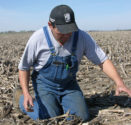Advertise Follow Us
Articles Tagged with ''marestail''
Fall Sprays Make No-Till Work Better
Shane Reinneck says keeping fields free of henbit, marestail and winter annuals helps him plant earlier and start clean in the spring.
Read More
Spraying Late Is Costly
You’ll sometimes have less than a day to make a timely herbicide application — at a time when it may interfere with other essential no-till work.
Read More
No-Till Weed Shifts Alarming
Resistance is increasing as weeds adapt to different tillage practices, rotations and herbicides.
Read More






